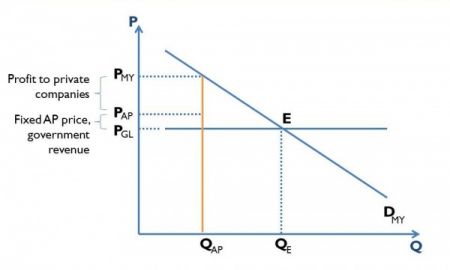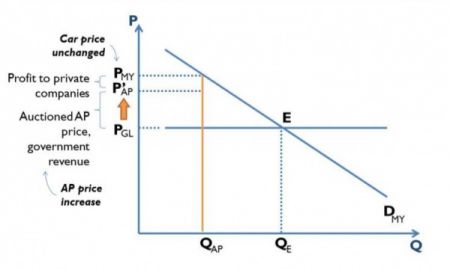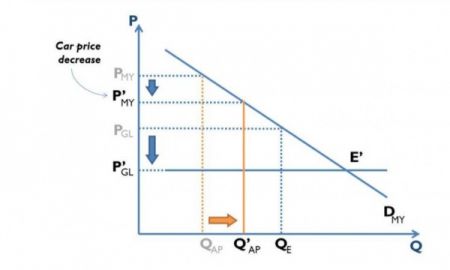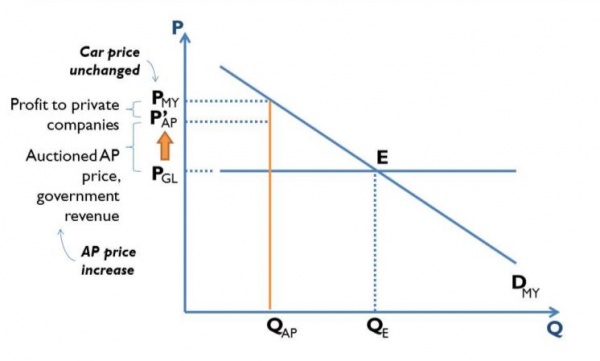Last week, Bernama and other sources reported Dato’ Mukhriz Mahathir’s bewilderment at Pakatan Rakyat’s proposal to auction Approved Permits (APs) to import cars. Essentially, Mukhriz said that auctioning APs (instead of giving them out at a fixed price) would increase car prices. Mukhriz is of course the Deputy International Trade and Industry Minister. In a letter to Malaysiakini, Pakatan Rakyat’s Rafizi Ramli promptly responded to these concerns, describing in generous detail why the good Deputy Minister had been mistaken.
Of course, only one of them can be right. I drew some graphs to help illustrate who was right (spoiler alert – it’s Rafizi), and where the other person (read: Mukhriz) may have got it wrong. The mistake comes down to an oversight of one of the most basic concepts in economics: that prices are determined by both supply and demand.
To illustrate how this basic concept comes into play in this case, I drew some simple graphs. So if you’re like me and you like pictures, maybe this explanation will be helpful.
Let’s start with the status quo, illustrated in Figure 1.

Variables:
PGL = Global price of cars imported to Malaysia, including taxes, duties, and shipping cost (for simplicity, we pick a single price for imported cars and assume the Malaysian market has no effect on the global price)
DMY = Aggregate demand curve for imported cars in Malaysia
E = Market equilibrium, in absence of AP limits
QAP = Number of APs issued
PMY = Profit maximizing price for imported cars in the Malaysian market if QAP APs are issued
PAP = PGL + Price of APs
The purpose of issuing APs is to limit the number of imported vehicles in the Malaysian market to give an advantage to local automotive makers. Without the AP system, Malaysians would buy more imported cars (QE imported cars at the global price PGL) and fewer local cars. Instead, the government issues only QAP APs to import cars, and issues them to selected importers.
By reducing the supply of imported cars to QAP, price (you guessed it!) increases. Malaysians are now willing to pay PMY for imported cars, instead of PGL. This is where I’m guessing Mukhriz forgot about the demand curve. Perhaps he assumed that Malaysians pay PAP, not PMY.
So, where does the extra money (PMY – PGL) go to? Some of the money (PAP – PGL) goes to the government when it sells the APs to the importers. The remainder (PMY – PAP) turns into profit for either the importers, or the dealers who buy the cars from the importers.
Auctioning APs
So what happens if the government auctions the APs instead of giving them to select importers? Will car prices increase? Let’s take a look at Figure 2.

If APs are auctioned publicly, dealers no longer need to depend on importers – they can buy APs directly from the government. The dealers will start bidding at the original AP price (PAP – PGL). They will bid higher and higher, continuously increasing the AP price (P’AP – PGL) until P’AP is so close to PMY that paying any more for APs would make selling cars unprofitable.
The price of APs has increased, but the price of the cars PMY remains unchanged.
All else constant, the price of the cars will only increase, as Mukhriz reportedly asserted, if to begin with, importers and dealers were not selling the cars at the profit-maximizing PMY.
Dealers don’t lose
So where does the money go to now? Under the auction system, a much larger share (P’AP – PGL in Figure 2) will go to the government, while dealers will make PMY – P’AP.
But dealers do not lose out. The only party that loses is the middle-person – importers – who are made redundant (of course, some companies are both importers and dealers). Under the original AP system, the dealers were engaging in the same bidding process, only they were beholden to the importers instead of the government.
Reduced duties reduce car prices
Pakatan Rakyat also plans to reduce car prices by reducing duties. This will of course work, but how this will reduce prices of imported cars is less straightforward compared to how this will reduce prices of locally made cars.

Reducing duties alone (PGL to P’GL in Figure 3) will not directly reduce prices of imported cars. As long as QAP remains the same, PMY will remain unchanged.
But by reducing duties on all cars, the demand for all cars will increase and more cars will be purchased. QAP is set at 10% of total market volume. So, when more cars are bought and the market volume increases, QAP will increase proportionally, to Q’AP. With this increase in supply of imported cars, PMY decreases to P’MY.
The government currently issues APs at RM10,000 per AP to around 100 select companies. As Rafizi explained at a forum on car prices, the government could gain more than RM3 billion every year by auctioning the APs.
So there you have it. By overlooking the basic concept of supply and demand, our Deputy Minister has dismissed a multi-billion ringgit opportunity.


Awesome post admin thanks for sharing.
There are sevral resources that are required by the organizations. These resources are signification so that it can car prices assured on the customer's demand.
actually, great article and youre right. maybe you should do a brief article on malaysian made car prices vs ap prices (assuming a decrease). then have another article (a part 2) on motorcycle prices vs ap prices. then a part 3 with accident/death rates of motorcycle users vs automobile users. you'd be a star. more power to ya.
Can't tell if you're being sarcastic or not, but thanks haha. I don't plan on writing more on APs at the moment, but we'll see!
I think you should re label your y axis to "length of article" and x axis to "readers ability to give a F*ck"
RC, good job, great to see you putting your Econ 101 skills to work. The Msian government officials never cease to amaze me with their stupidity. I met someone at Bank Negara recently who has no freaking ideas what he was talking about but he managed our country FX reserve.
Thanks. Econ 101 A-levels HELP to be exact hahah. Is this Chee?
Sifu
Oh hahaha ok
How bout an animated video short video to explain this?
Great idea! When I was writing this up, I thought the same thing. The Khan Academy (www.khanacademy.org) is a good concept to reference. Will think about it for future posts.
MOo Kriss dont understand your article – as it is too complex.. moo Kriss understand only — CRONIES N APS saja
Nice!
Yup – 101 stuff that can be surprisingly easy to miss
Don't throw pearls amongst the swine ? Your well presented figures will not be understood by the descendant of an Umno made Malay who is a deputy trade minister not because of his ability or intelligence but because of his father's influence. Plus of couse a further proof of why the cunning man made Malay is adamantly claiming to be a Malay when he is just a descendant of a pariah !
Like everything else everything has to come to an end so has his position too in the cabinet that is why he is giving the excuse of going back to the country town of Kedah to be the CM/. Nut I suppose the rooster is going back to end the cycle of deception and fraud. From dust the pariah came to dust the pariah should return ! Law of Allah and Newton.